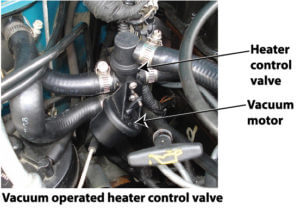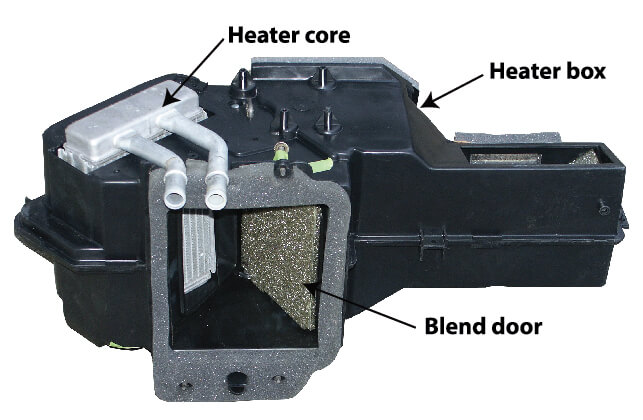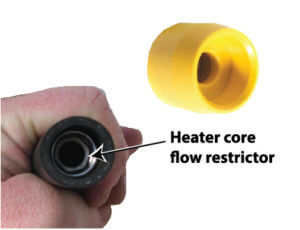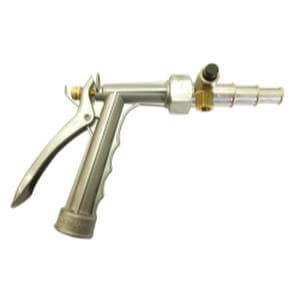What is a heater core?
How does a heater core work, and what makes it fail?
A heater core is nothing more than a small radiator located in your vehicle’s cabin. As your engine runs, the water pump pulls in cold coolant from the bottom of the radiator at the front of your car and forces it through your engine from the bottom up. The coolant absorbs engine heat and flows out the top of the engine into the heater box under your dash. There, a blower fan blows cabin air across the heater core fins to heat interior air, warm passengers, and defrost your windshield. The coolant then returns to the water pump to be circulated to the main radiator at the front of your car, cooled by ambient air.
How does a heater core regulate heat?
Car makers use two methods to regulate heat: older cars use a heater control valve to control coolant flow through the heater core, while newer cars allow full-time coolant flow and regulate temperature by varying how much air passes through the heater core.
Heater control valves of often operated by a cable connected to the knob at the heater control head in the cabin. However, an electric or vacuum motor can operate some heater control valves. The opens and closes fully or partially, allowing full or partial coolant flow into the heater core. Car makers have moved away from this method because it can accelerate internal corrosion when the valve is shut down completely for an entire season. If the owner hasn’t kept up with recommended coolant changes,  the old and worn coolant can sit in the core through spring, summer, and fall and corrode the passages. Then, when the owner turns on the heat for winter, there’s limited flow and poor heating.
the old and worn coolant can sit in the core through spring, summer, and fall and corrode the passages. Then, when the owner turns on the heat for winter, there’s limited flow and poor heating.
Blend doors eliminate some heater core corrosion issues
In a blend door system, the water pump supplies a constant flow of hot coolant, even in the dead of summer. The system operates a “blend” door that partially or fully allows air to flow or not flow past heater core fins. The advantage of this system is that engine coolant never stagnates in the heater core. But this approach isn’t risk-free.
 Constant coolant flow through the tiny tubes can wear out the thin tubing, causing it to leak. Plus, full flow can make a gurgling noise. To combat premature wear and increase the time the coolant is inside the unit, car makers often install a flow restrictor in the heater hose running from the top of the engine and into the heater core. The restrictor helps transfer more heat. If the
Constant coolant flow through the tiny tubes can wear out the thin tubing, causing it to leak. Plus, full flow can make a gurgling noise. To combat premature wear and increase the time the coolant is inside the unit, car makers often install a flow restrictor in the heater hose running from the top of the engine and into the heater core. The restrictor helps transfer more heat. If the  heater hose is ever replaced with a hose that doesn’t have a restrictor, the excessive flow will wear out the small tubes, causing a low heat or no heat complaint.
heater hose is ever replaced with a hose that doesn’t have a restrictor, the excessive flow will wear out the small tubes, causing a low heat or no heat complaint.
The second disadvantage of a blend door system is that the core is always hot when the engine is at operating temperature, so the heater box is always hot. That can heat the chilled air from the car’s AC system, putting a slight additional burden on the vehicle’s AC system.
How much heat does it output?
Heater cores are sized to fit the vehicle’s cabin size and the expected heat from the engine. Most provide an 85° to 100°F temperature increase to the cabin once the engine is at operating temperature. If the engine is at full operating temperature and the temperature outside is 0°F, the air blowing through the heater core should be around 90°F.
What causes a heater core to fail?
• Excessive flow rates due to a missing restrictor can wear out the heater core tubing, causing it to leak
• Worn-out coolant that allows corrosion in the cooling system, causing clogging in the small passages.
• Worn-coolant that allows galvanic electrolysis to occur, moving metallic ions out of the core so it develops holes and leaks coolant into the heater box.
• Using the wrong coolant can cause incompatibility issues with the materials used throughout the cooling system. That can cause corrosion, but it can also cause seals and hoses to deteriorate and shed material that eventually clogs the heater core tubes.
All core failures are due to either owner neglect or shop error in not replacing a flow restrictor.
What are the symptoms of a bad heater core?
Your windshield is fogged with a greasy film
A heater core leak can mist coolant into the airflow and blow it onto your windshield. This fogging type differs from normal fog accumulation from moisture in the air hitting a cold windshield.
A leaking heater core will usually not fog the windshield on cold startup because the coolant is cold and is less able to atomize as it leaves the heater core. However, once the engine is at operating temperature, the leaking coolant will leak and atomize, causing the water in the coolant to turn to steam and carry the ethylene glycol onto your windshield.
You notice a sweet smell in the cabin
Ethylene glycol coolants smell like sweet fruit juice. If your heater core leaks, the coolant can pool at the bottom of the box, and the airflow will pick up the scent and send it through your vents. A larger heater core leak will send the excess fluid down the AC drain tube, causing it to puddle under your car. Check for a coolant puddle if you notice the sweet smell while exiting your car.
You’re losing coolant
A small amount of coolant can evaporate from your reservoir over time, so don’t be alarmed if you have to top off the reservoir once a year or so. But if you have to top off the coolant more frequently, you have a big cooling system problem. The leak can be anywhere in the cooling system.
Check the carpeting on the passenger side of your car. If the carpet is wet and the fluid has an oil feel, your heater core is leaking.
You’re not getting any heat or just luke-warm hear
As I said earlier, low coolant, a stuck open thermostat, and a faulty water pump can also reduce heating. But if you’ve checked those items and still don’t have heat or low heat, chances are it’s clogged
How to check for a clogged heater core
Open the hood and locate the two hoses running to the core. The hoses will run from the engine to the firewall. Feel the hoses.
If one hose is hot and the other cool to the touch, coolant isn’t flowing properly into and out of the heater core. Both hoses should be close to the same temperature. That could be caused by a plugged core or an air pocket. Try purging air from the heater core by removing the hose clamp and removing the return hose slightly—just enough to burp the system.
What to check if you’re not getting heat in your car
1. Check the coolant level. When coolant is low, the car’s heater core will be the first to lose coolant flow, which will cause low or no heat.
2) Check the coolant condition for scale and electrolysis (see the post below on how to check for electrolysis using a digital multimeter).
3) Check the engine temperature with an infrared noncontact thermometer near the thermostat housing to determine if the thermostat is working properly. After running for a while, the thermostat housing should read around 190°F.
4) Check blend door or heater valve operation. If both heater hoses feel hot, that confirms the heater core is getting hot coolant and that the coolant is flowing through the core (otherwise, one hose would be hot and the other cold). Locate the blend door and operate the heater control to see if the electric or vacuum motor actuator opens and closes the blend door. If there’s no movement, disconnect the actuator and move the blend door by hand. If that provides hot air, diagnose the actuator to determine why it’s not operating.
If your car has a heater control valve, manually open and close the valve to see if that solves the problem. If so, replace the faulty valve or actuator.
5) Flush the heater core. Several companies make a heater core  flushing tool that’s somewhat effective in removing sediment from the core. If that works, it can save you from replacing the heater core, a very expensive repair.
flushing tool that’s somewhat effective in removing sediment from the core. If that works, it can save you from replacing the heater core, a very expensive repair.
©, 2016 Rick Muscoplat
Posted on by Rick Muscoplat
